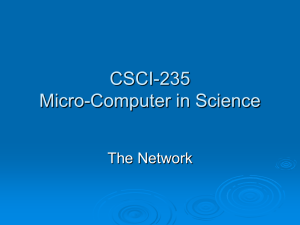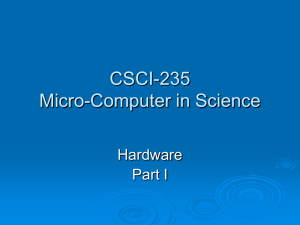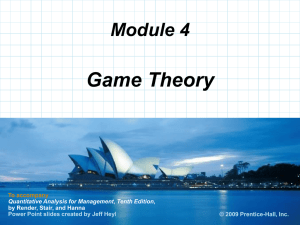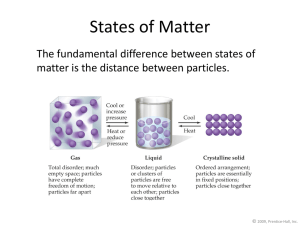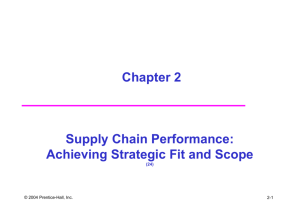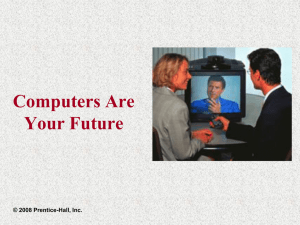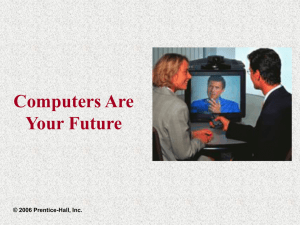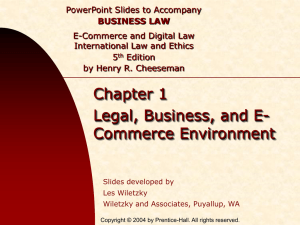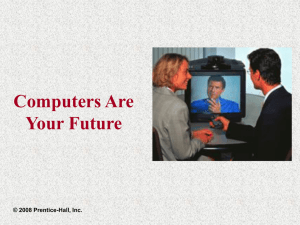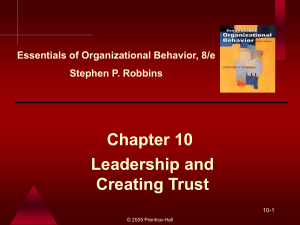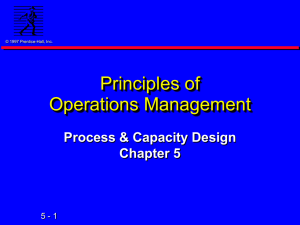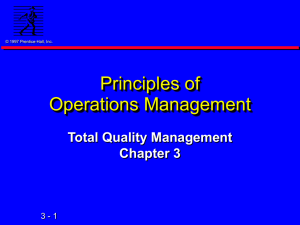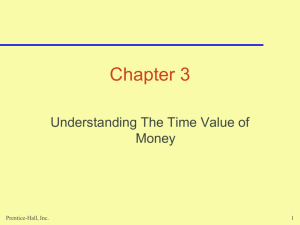Person-focused pay
advertisement
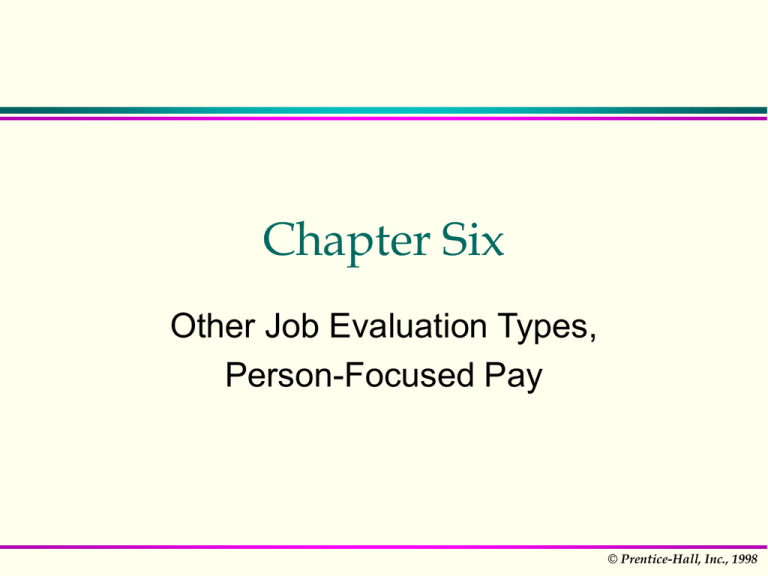
Chapter Six Other Job Evaluation Types, Person-Focused Pay © Prentice-Hall, Inc., 1998 Other Job Evaluation Types Classification Ranking Market Pricing Competency-Based © Prentice-Hall, Inc., 1998 Ranking Whole job technique Rank jobs high to low Easy, inexpensive, informal Effective when: few, similar jobs Popular with small companies Subjective, non-specific May be hard to defend Simple, Alternative, Paired Comparison © Prentice-Hall, Inc., 1998 Paired Comparison Ranking Compare each job against every other job Give a “win” (X) if the job is more valuable Rank according to frequency of “wins” Results: Shift Supervisor Control Rm Opr Equipm’t Opr Laborer Control LaborerS hift Control Room Opr X Laborer Shift Supervisor X X Equipment Opr X 3 2 1 0 Equipment TOTAL X 2 0 X 3 1 © Prentice-Hall, Inc., 1998 Classification Whole job technique Slot jobs into labeled classes Classify jobs by similarity to prototypical/benchmark job, label, and compensable factor Common in public sector Federal gvt: Factor Evaluation system GS classification system: 18 classes Used for wide variety of dissimilar jobs Inexpensive, simple, flexible Difficult to build classes, generic classes, vague descriptions © Prentice-Hall, Inc., 1998 Job Classification Schedule GS 9 Includes all classes of positions the duties of which are (1) to perform, under general supervision, very difficult and responsible work along special technical supervisory, or administrative experience which has (A) demonstrated capacity for sound independent work, (B) thorough and fundamental knowledge of a special and complex subject matter, or of the professional, art, or science involved, and (C) considerable latitude for the exercise of independent judgment; (2) with considerable latitude for the exercise of independent judgment, to perform moderately difficult work requiring (A)...College degree... (B)...additional training or experience...; or (3) to perform other work of equal importance, difficulty, and responsibility, and requiring comparable qualifications. © Prentice-Hall, Inc., 1998 Market Pricing Determines market rate for each job Pays market rate Ignores internal consistency in favor of external competitiveness Rates may be unrelated to relative value of skills, responsibility, value within the firm © Prentice-Hall, Inc., 1998 Competency-Based Pay One of fastest-growing personnel innovations in U.S. Mostly in service and manufacturing industries Rewards employees for acquiring job-related competencies, knowledge, skills rather than demonstrating successful job performance. Includes pay-for-knowledge and skill-based pay Pay-for-knowledge rewards managerial, service, or professional workers for successfully learning specific curricula. Skill-based pay rewards employees who do physical work for mastering new skills © Prentice-Hall, Inc., 1998 Competency-Based Pay Pay based on knowledge or skill, not the job performed Employee carries the wage, regardless of the tasks performed Pay increases are linked to knowledge/skills, not promotions Assess and values skills, not jobs © Prentice-Hall, Inc., 1998 Pay for Knowledge Skill Blocks Horizontal skills Similar skills/knowledge, e.g. several types of record-keeping tasks. Vertical skills Supervisory skills, e.g., scheduling, training, coordinating. Depth of skills Level of specialization or expertise: specialize in particular aspect of job. © Prentice-Hall, Inc., 1998 Varieties of Pay-for-Knowledge Programs Stair-step model » Steps represent jobs from a particular job family that differ in complexity » Focus on skill/knowledge depth Skill blocks model » Jobs in same job family, employees progress to increasingly complex jobs, but skills do not build on each other. » Focus on horizontal and vertical skills Job-point accrual model » Focus on skills/knowledge that bear directly om companies attainment of co petitive advantage Cross-departmental models » Focus on staffing flexibility. Traian one departmewnt with critical slills ned to perform in other departments. © Prentice-Hall, Inc., 1998 KBP--Increased Knowledge Systems: $7.00 Base Rate $7.35 $7.70 $8.05 Level 2 Rate Level 3 Rate Level 4 Rate 1Job Function 1 Job Function 1 Job Function 1 Job Function +1 know. cell +2 know. cells +3 know. cells +know. cells Safety/ Housekeeping Safety/ Housekeeping Preventive Maintenance Safety/ Housekeeping Preventive Maintenance Product Knowledge Safety/ Housekeeping Preventive Maintenance Product Knowledge SPC © Prentice-Hall, Inc., 1998 KBP--Multi-Skill System $7.00 $7.35 $7.70 $8.05 Base Rate Level 2 Rate Level 3 Rate Level 4 Rate Mastery of 1 job Mastery of 2 jobs Mastery of 3 jobs Mastery of 4 jobs Filter Assembly Filter Assembly Material Handling Filter Assembly Material Handling Final assembly Filter Assembly Material handling Final assembly Polish/QC © Prentice-Hall, Inc., 1998 Borg Warner Auto Assembly Classifications CURRENT measurer nChain checker nUltrasonic tester nInspect/repair nChain cleaner/oiler nChain Packer FUTURE nChain nCell Operator C nCell Operator B nCell Operator A Inc., 1998 © Prentice-Hall, nRiveter nAssembler hand machine nAuto assembler Exhibit 6-4 Skill-Based and Job-Based Pay: A Comparison FEATURE SKILL-BASED JOB-BASED Pay level determination Base pay Market bases for skill valuation Awarded on how much as employee knows or on skill level Awarded on an employee’s gain in knowledge or skills Awarded on an employee’s skills base and proficiency on past work Job variety and enrichment Market bases for job valuation Awarded on the value of compensable factors Base pay increases Job promotion Key advantage to employees Key advantage to employers Work scheduling flexibility Awarded on attaining a job-defined goal or seniority Awarded on exceeding job performance standards Perform work and receive pay for a defined job Easy pay system administration © Prentice-Hall, Inc., 1998 Exhibit 6-3 Skill-Level-Performance Matrix SKILL LEVEL1 HOURLY PAY FOR PERFORMANCE RATING BELOW AVERAGE AVERAGE ABOVE AVERAGE Clerk I Clerk II $5.25 $5.50 $5.75 $6.00 $6.25 $6.75 Clerk III Clerk IV Clerk V $5.70 $5.95 $6.20 $6.30 $6.60 $6.85 $7.25 $7.45 $8.25 1Skill defined according to a skill blocks model (as in Exhibit 6-2). © Prentice-Hall, Inc., 1998 Advantages Advantages to Employers Employees see compensation as a reward rather than an entitlement Competitiveness Technological innovation—skills become obsolete Increased global competition—more productive requires leading-edge skills Improved job performance, reduced staffing, greater flexibility Advantages to Employees Increased job enrichment: skill variety, task identity, autonomy, feedback. Increased job security © Prentice-Hall, Inc., 1998


